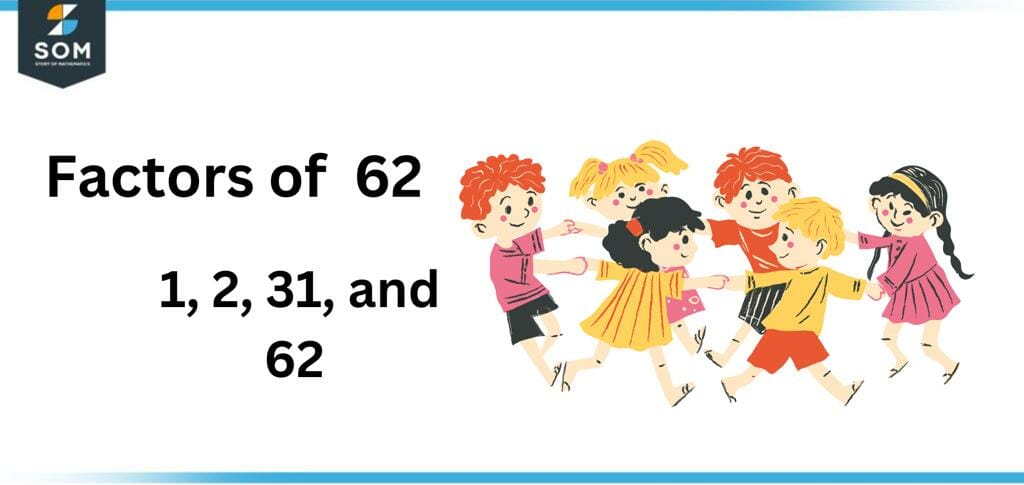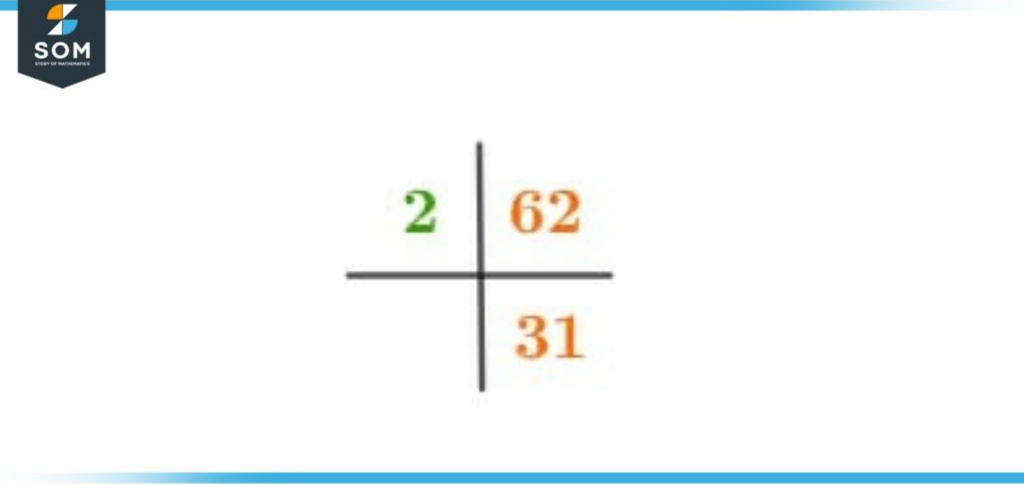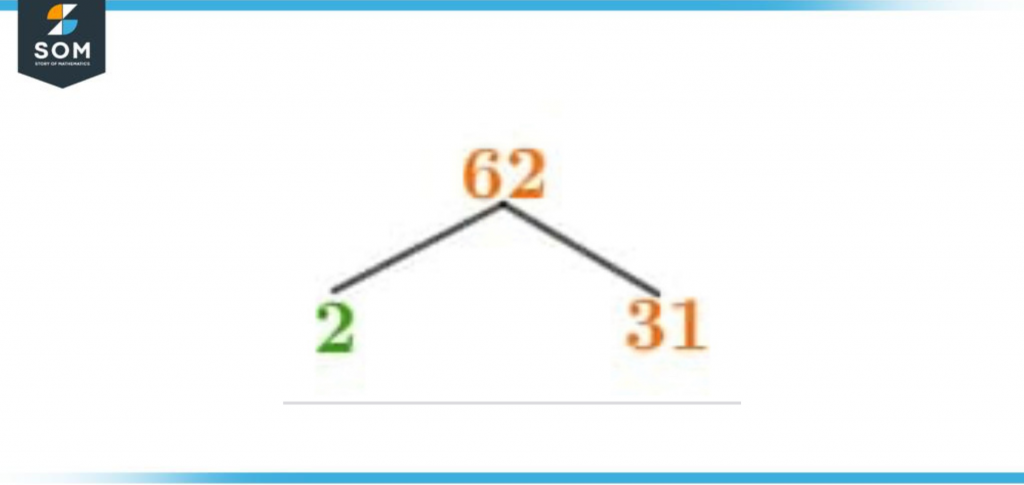JUMP TO TOPIC
Factors of 62: Prime Factorization, Methods, Tree, and Examples
Any number is referred to as a factor of 62 when it divides 62 without leaving any remainder or giving the quotient in decimals or fractions. Remember that a factor is supposed to be a whole number. It cannot be a fraction or in decimals.
Figure 1 – All possible Factors of 62
What Are the Factors of 62?
Factors of 62 are the following: 1, 2, 31, and 62 itself. These numbers can only divide 62 fully without leaving any remainder.We can see that 1 is the mandatory factor here. Since 62 is an even number, two is in its factor list. Also, 62 has four factors that prove that it is an even composite number.How To Calculate the Factors of 62?
The easiest and most convenient way of calculating factors is to use the division method. Although the technique of multiplication can also be used, it is more time-consuming, and there are more chances of missing a factor because of lengthy workings.Both these methods are somehow related to each other. Successful working in both ways provides us with two factors at once.We will consider the numbers smaller than or equal to half of that given number for both methods. This is a trick to save your time and effort. However, you can always consider numbers till the number itself for your satisfaction.For the division method, we will start with the smallest number other than 1. Then we will divide the given number by a smaller number to see if the quotient we get is in the whole number or not.If the quotient is a whole number, the smaller number has divided the given number fully. Now both the quotient and the divisor will be considered as the factors of that given number.Again, you don’t have to do the calculations for the quotient you calculated. Once you have done your calculations, add one and the number to the final list.For the factors of 62 through division, we will have to find the half of 62 first.\[ \frac{62}{2} = 31 \]Now we will consider all the numbers from 2 to 31 and divide 62. Once you have done your calculations, add one and the number itself to the final list to complete the list.After calculations, we can say that 2 was the only number to divide 62 fully by giving the quotient 31. Both 2 and 31 are now considered as the factors of 62, along with 1 and 62. So the final factors are 1, 2, 31, and 62.For the method of multiplication, make pairs of different pairs. Multiply them to see which numbers are multiplying to give the product of the given number.The numbers multiplied to give the required answer will be considered as the factors of that certain number. Add one and the number itself in the final list.Both the multiplying numbers need to give no remainder and have to be whole numbers. This method is time-consuming but generates the same answers if done carefully.For finding the factors of 62 through multiplication, we will consider numbers till 31, make pairs of these numbers, and then check which numbers generate the required answer.For 62, only two pairs of numbers generate the required answer. They are;1 x 62 = 62
2 x 31 = 62
Now 1, 2, 31, and 62 are considered as the factors of 62.Factors of 62 by Prime Factorization
Prime factorization is a useful method to break down a number to extract its prime factors. Prime factors are the prime numbers in a certain number’s factor list. This method is also known as the method of decomposition.The numbers that have only two factors are prime numbers. Other numbers with more than two factors are called “composite numbers.”
Knowing whether the given number is a prime number is essential, as prime factorization and factor tree methods are always accessible and lifetime-consuming for prime numbers.
For breaking down a number, we will start by dividing the number with the smallest divisible number, other than 1. 1 will only be considered in the case of prime numbers.If the quotient calculated is a prime number, the process would end there. But if it is not a prime number, the process will continue until both the quotient and the divisors are decomposed into their prime factors through the division with their smallest divisible numbers.This process is relatively easy for prime numbers. You will divide the prime number with one to get the exact number as your quotient. This process will stop there as dividing the number again will give the same answer.For the prime factorization of 62, we will divide it by two; we will get 31 as the quotient. This would end here as both 2 and 31 are prime numbers.Prime factorization resembles the method of LCM when represented. All the divisors are written on the left-hand side, and the quotients are written on the right-hand side.An image of the diagram of prime factorization of 62 is attached below:
Figure 2 – Prime Factorization of 62
Factor Tree of 62
A factor tree is one of the many ways to represent the prime factors of a number. This method can also be used to describe the data of prime factorization.The given number, in this method, is written on the top. It is divided by the smallest divisible number other than 1. You will note the divisor on the left-hand side by extending a line below the quotient on the right-hand side in the same way.Both numbers will be checked to see if they are composite numbers. If there is a composite number, divide it similarly until you get prime numbers as your final answer.For prime numbers, you will divide the baby 1 on the left-hand side by extending a line below that number and the quotient on the right-hand side in the same way.The diagram of the Factor Tree of number 62 can be seen below:
Figure 3 – Factor Tree of 62
Factor Pairs of 62
A factor pair is formed when two numbers multiply to give a certain number as their product. A factor pair can be both positive and negative. Both of the numbers need to be whole numbers and not have decimals or fractions.A factor pair can be both positive and negative. A pair formed by both positive numbers can also create a negative pair just by changing the signs of both factors too -.Both the factors calculated by one successful calculation of division and multiplication methods together form a factor pair for that specific number. One and the number itself are always going to start the factor pair for any number.For 62, 1 and 6 forms the first pair, and 2 and 31 include the second pair. Both of these are represented as (1, 62) and (2, 31).Factors of 62 Solved Example
Example 1
Write down the factors of 62 and determine the factor pairs as well.Solution
The factors of 62 are 1, 2, 31, and 62. Factor pairs of 62 are (1, 62) and (2, 31).Example 2
Find the sum of the factors of 62.
Solution
The factors of 62 are given as follows:Factors of 62 = 1, 2, 31, 62
Sum = 1 + 2 + 31 + 62
Sum = 96
Therefore, the sum of all the factors is 96.
All images/mathematical drawings are used using GeoGebra.